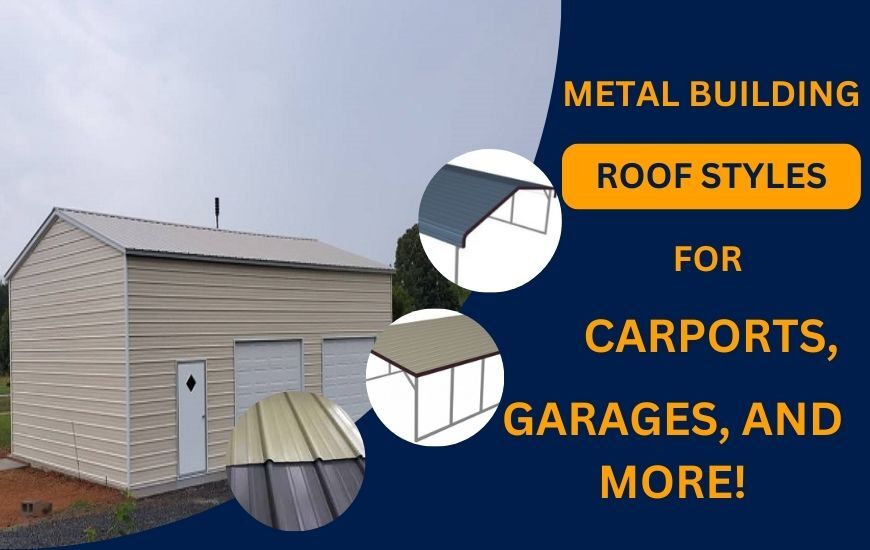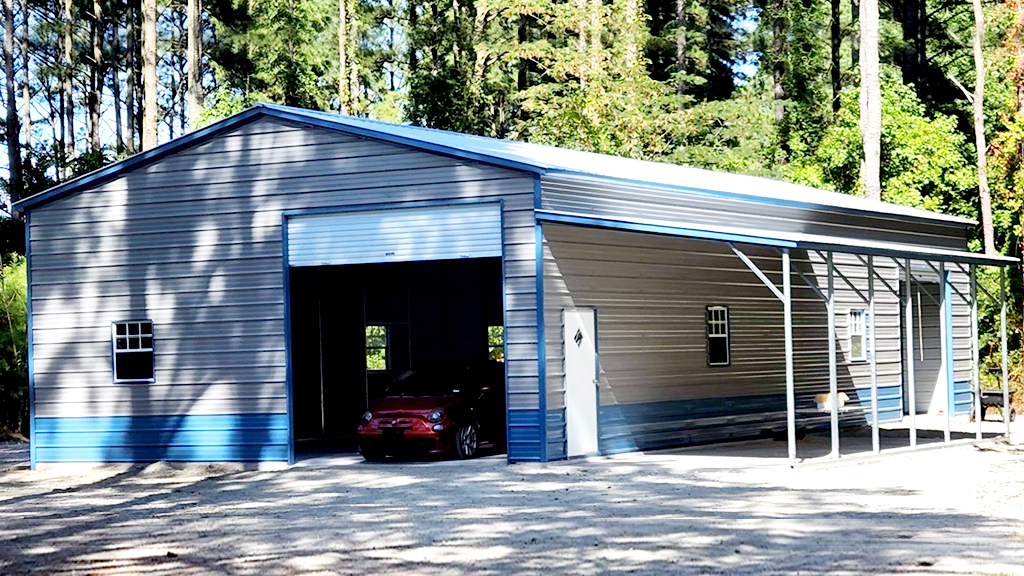
While it might not get as much attention as it deserves, a metal building’s roofing system is one of the most crucial components of the structure. It not only plays a prominent role in defining your carport or metal garage’s look, but it will also dictate how effective it is against your region’s climate. The structural integrity of a building will rely on this roofing system, so you’ll want to choose the best one for your environment and needs.
This guide will dive into the various roofing systems used for metal buildings, detail their uses, and cover some frequently asked questions about the subject. So, if you’ve been considering a new metal building for your home or business, you’ll want to stick with us!
If you’ve ever seen traditional metal carports, you’re likely already acquainted with the regular roofing style. It features rounded corners, a shallow roof peak, and horizontal paneling that runs along the span of your roof. A trusted favorite, regular roofs are your ‘quintessential’ carport roof and provide buildings with a fresh, modern feel.
Regular roofs are among the most economical roofing options, offering protection without breaking the bank. However, regular roofing systems are designed to handle mild climates with minimal wind and rainfall totals, so if you live in a region with volatile weather, you might need a more robust roofing solution.
Also known as an A-frame roof, boxed-eave roofing systems closely resemble the roofing type you’d see on a traditional residential home. It features overhanging awnings, a sharper roof pitch, and horizontal paneling.
Regarded by many building authorities as an excellent mid-tier option, regular roofs are ideally suited for most moderate climates. It’s also crafted to hold up well against most high winds. However, this roofing system is not as effective when pitted against regions with high rainfall. As such, you’ll need to plan accordingly based on your region’s weather.
The vertical roofing style is known as the cream of the crop in terms of protection, effectiveness, and longevity. It’s designed to combine the best aspects of a boxed-eave roof design with vertically oriented paneling. This clever engineering technique may seem simple, but it does wonders for extending the life of your roofing system by allowing rain, debris, leaves, and snow to slide off your roof to the ground.
By reducing objects along the roof that can retain moisture and promote oxidation, vertical roofing systems can provide you with decades of service beyond other roofing types.
If you’re not familiar with the process of designing a carport or metal building, it’s understandable that you might have a few questions. And that’s precisely why we’re here! To shed more light on these incredible roofing components, we’ve gathered a few of the most frequently asked questions on the subject.
While shake and shingle roofs work for most construction types, they pale compared to the effectiveness of metal roofing systems. For example, on average, you can expect a standard shingle roof to last for about twenty years. But a vertical metal roof often comes with warranties guaranteeing them for over 50 years.
While shingle roofs are probably cheaper to install in most cases, you’ll still lose money over the course of their life compared to a metal roofing system. Metal roofs last much longer than any other roofing type and will save you money time and again when it comes to repairs and maintenance.
Simply put, yes. Factoring in the installation cost and their extensive lifespan, metal roofing systems are some of the most cost-effective roofing options on the market.
Thanks to their vertical paneling, any debris, such as snow, leaf fall, or tree limbs that fall on your roof, will slide away to the ground. Preventing standing debris along your roof will greatly minimize the possibility of rust or deterioration. And, thanks to vertical roofs, keeping your roof clean has never been easier.
Unfortunately, determining how much of a snow load a roofing system can withstand is a simple process. As such, you’ll need to work closely with your engineer and building specialist to determine vertical roofing systems’ wind, snow, and seismic load capabilities.

So, you’ve purchased a carport or one of the many metal building kits. That’s great! Your structure will undoubtedly provide you with years of dedicated service. But before completing the design process, you’ll need to choose a roofing style for your steel structure. Important things to consider here include:
Even though metal buildings are designed to stand up to just about any environment in the US, it’s still vital to choose the right system for the job. And unfortunately, some roofing styles aren’t up to the task. For mild climates, a regular roof will undoubtedly do the job. But if you live in an area that regularly sees high winds, heavy rainfall, and snow accumulation, you’ll need a more reinforced option.
In most cases, your roofing system will either have horizontal or vertically arranged paneling. For some, this might only be an aesthetic difference. But you’ll need to know that vertical paneling is regarded as the more substantial option. Not only will vertically oriented roofing panels reduce debris from remaining on your roof, but they’re also just downright stronger.
Another crucial aspect that determines your roofing system’s effectiveness is its thickness. In most residential applications, 29 gauge paneling is the industry standard. But if your region experiences severe wind speeds or heavy snowfall totals, you’ll want to choose the thicker 26 gauge option.
The slope of your building’s roof will also be an important factor to consider. Roofs with lower pitches use fewer materials than steeper options and are regularly used for commercial applications. On the other hand, steeper sloped roofs might be a more expensive choice, but they provide additional strength for residential projects.
No matter where you live, Garage Buildings is dedicated to providing you with quality structures, industry-backed guarantees, and affordable prices. It doesn’t matter whether you’re interested in full-sized metal garages or simple DIY metal building kits; we’ve got the experience and skill to deliver lasting results.
We also aim to make owning a steel structure affordable, regardless of budget. That’s why we’re proud to provide a great lineup of flexible financing packages that give you the power to own your building, no matter your financial capabilities!
So, if you’re looking for a long-lasting solution for protecting your cars, trucks, SUVs, RVs, or boats, give Garage Buildings a call at +1 (866) 355-4442! We’re waiting to help you design and install a structure that works for all your residential, commercial, or industrial needs!